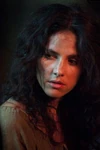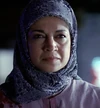[[:Category:{{{Images}}}|Images]]
- "There can't be peace, until there is justice. For me, for Antonia, for all the women you tortured and burned for centuries, all to repress the magic that was older and more powerful than your very existence!"
- ―Marnie Stonebrook, to Bill Compton and Eric Northman
A witch is a man or woman who is learned in Witchcraft. Witches are one of the most powerful antagonists of the vampire race in the HBO original series True Blood.
History
Humans who practice magical powers are called "witches". While the origin of witchcraft remains unknown, it is believed that witches have existed for thousands of years, passing down their knowledge and skills through generations of family lines. Contrary to popular belief, not all witches channel their power from demons, nor do they worship the devil. Instead, most witches, especially Wiccans, channel their power from nature and may practice their witchcraft however they see fit. However, according to Nan Flanagan, ever since the Spanish Inquisition that took place in the 1600s, the practice of witchcraft has severely declined over the centuries to the point where most vampires no longer view them as a threat. And while most modern practitioners, such as Holly Cleary, tend to follow Neopagan religions and commonly treat witchcraft as a spiritual practice, it is known that some humans continue to practice witchcraft specifically for the power that comes with it. According to Bill Compton, these individuals are capable of becoming very powerful, and have been known to match, or in some cases, overpower even the oldest of vampires. While the limitations of their power remain unknown, it is believed that witches are one of the most powerful creatures of all time. According to Marnie Stonebrook, witchcraft is supposedly older than vampirism, and claims that vampires have tried for centuries to repress the magic that is more powerful than them.
Magic
Magic is the power to affect change by supernatural means. Magic can often be split into black and white, though depending on the situation, may also be neutral. All humans are connected to this power and may access it through practice and training. Whilst all humans are able to cast spells and perform other feats of magic, witches are known to have more knowledge and understanding of the supernatural forces that permeates the entire universe. It is also likely that some individuals have a greater connection to magical forces and therefore more affinity with magic.
Black Magic
Black Magic (or Dark Magic) is a form of sorcery that draws on malevolent powers, and may be used for negative purposes (e.g. to cause destruction or misfortune, to injure or kill, or for the profit of oneself rather than for the benefit of others.) In popular usage, the term "black magic" is often used to describe any form of sorcery that is used negatively.
Note
Black magic is commonly, but not always, practiced by witches who channel their power from demons.
White Magic
White Magic (or Light Magic) is a form of sorcery that draws on benevolent powers, and may be used for positive purposes that deliberately causes help in some way (e.g. to cure or protect, to improve or restore, or for the benefit of others rather than for the profit of oneself.) In popular usage, the term "white magic" is often used to describe any form of sorcery that is used positively.
Note
White magic is commonly, but not always, practiced by witches who channel their power from nature.
Wicca
Wicca is a religion whose adherents are alternatively called Wiccans. By contrast, traditional witchcraft is not a religion, but a universal magical practice that transcends any religious belief or lack thereof. While Wiccans generally acknowledge and revere a pantheon of gods and goddesses, traditional witches may belong to any religion or none, they may believe in a God or gods or they may be atheists. According to Holly Cleary, Wicca is an earth-centered, polytheistic religion, where the adherents are extremely conscious of their one "law" called the Wiccan Rede which advises them to "Harm None".
Witchcraft
Witchcraft is a practice of magic that encompasses many different types of activities including astrology, divination, spell casting, and spirit communication. It includes the practices of many cultures, nations and religions as well as many books and writings from ancient times. Depending upon the individual, some witches practice their power by certain belief systems, such as Shamanism, Voodoo, Wicca, or any number of other magical practices from countries and cultures all around the world. Although the majority of witches are portrayed as being spiritual human beings who use their powers for healing and protection spells; in the case of Marnie Stonebrook, it has been proven that not all witches are benevolent and are capable of practicing magic for malevolent deeds.
Magic Powers
Basic Powers
The basic powers of every witch include:
- Channeling: The act of drawing extra forms of energy from external forces of power.
- Potion Brewing: The act of brewing and concocting magical elixirs that have supernatural effects.
- Spell Casting: The act of changing and controlling events through the use of charms and incantations.
Other Powers
With years of practice and training, witches may develop other powers that include:
- Aura Reading: The power to perceive energy fields surrounding various people, places and things.
- Divination: The act of divining, or predicting, future, past, and present events based off extrasensory perception.
- Cartomancy: The practice of divination through the use of tarot cards.
- Clairvoyance: The practice of divination through the perception of emotions, objects, people, or physical phenomena.
- Intuition: The practice of divination through the use of instinctive knowledge.
- Palmistry: The practice of divination based off the features indicated on the human palm.
- Premonitions: The practice of divination through the observation and study of dreams.
- Psychometry: The practice of divination through contact with or proximity to a certain object or person.
- Rune Reading: The practice of divination based off the positions and symbols of runic stones.
- Scrying: The practice of divination through crystal-gazing or other forms of fortune tells.
- Tassomancy: The practice of divination based off the positions and symbols of tea leaves.
- Elemental Control: The power to control and manipulate the elements of air, earth, fire and water.
- Aerokinesis: The power to control and manipulate the element of air.
- Geokinesis: The power to control and manipulate the element of earth.
- Hydrokinesis: The power to control and manipulate the element of water.
- Pyrokinesis: The power to control and manipulate the element of fire.
- Astral Projection: The power to project the astral body from outside of the physical body in order to travel from one location to another.
- Levitation: The power to float or rise the physical body within midair through mental influence.
- Longevity: The power to live hundreds (possibly thousands) of years while maintaining a beautiful and youthful appearance.
- Mind Control: The power to control and manipulate the behavior and thoughts of another living creature.
- Necromancy: The act of controlling and manipulating the dead.
- Telekinesis: The act of controlling and manipulating the movement of objects and persons through mental influence.
- Teleportation: The act of disappearing from one location and instantly reappearing in another location through supernatural means.
Tools
- Amulets: Blessed objects that are commonly used to protect the wearer from external harm.
- Athames: A ceremonial dagger with a double-edged blade that is commonly used to direct energy.
- Books of Shadows: A personal grimoire that is documented with magical recipes, rituals, and spells.
- Candles: Block of solid wax with embedded wicks that are commonly lit to amplify a witch’s spell.
- Cauldrons: Large metal pots that are commonly used to hold the ingredients for elixirs and potions.
- Herbs: Earthly plants that are commonly used as ingredients for brewing and concocting paranormal potions.
- Stones: Small stones that are occasionally used as ingredients for brewing and concocting paranormal potions.
Weaknesses
- Magic: While most witches have been known to cast protection spells upon themselves, some witches are still susceptible to magical influences.
- Mortality: Based off the fact that witches are still human, they share many of the same weaknesses as non-supernatural beings (e.g. age, decapitation, disease, heart-failure, suffocation, etc.).
Trivia
- According to Marnie Stonebrook, magic has existed longer than vampirism and dates as far back as the beginning of the universe itself. Furthermore, Marnie claims that in order to ensure that the practice of magic remained unpopular, vampires have spent countless centuries demonizing the once sacred art of witchcraft. Marnie believes that by installing fear into the minds of humans, mainstream society now has the wrong impression of what magic truly is and thus this is the reason most people no longer practice.
- Contrary to popular belief, the term "warlock" is never used to describe a male witch. While other terms such as "brujo" is used to describe Spanish witches who receive their power from demons, or "necromancer" is used to describe witches who practice necromancy, it seems that "witch" is a gender-neutral term applied to both men and women.
- Prior to the Spanish Inquisition that that took place in the early 1600s, the practice of witchcraft was supposedly very common among the human population, especially among women. However, since the brutal witch trials that occurred during the 17th century, the practice of witchcraft has severely declined. According to Nan Flanagan, most humans nowadays do not practice magic, and for those that do, they practice non-threatening traditions of witchcraft (i.e. Wicca). When informed about a local coven in Shreveport using magic to resurrect a bird, Nan ignored the warning, calling the members "hippies" and telling Bill Compton that "they don't make necromancers the way they use to".
- While vampires are known to have a magic of their own, it has been implied that vampires cannot practice witchcraft. Nora Gainesborough explained to Eric Northman how unlike magic, faith was something that anyone could do, even vampires. Therefore, it is heavily speculated that only humans or other living beings can practice witchcraft.
Known Witches
|
|










